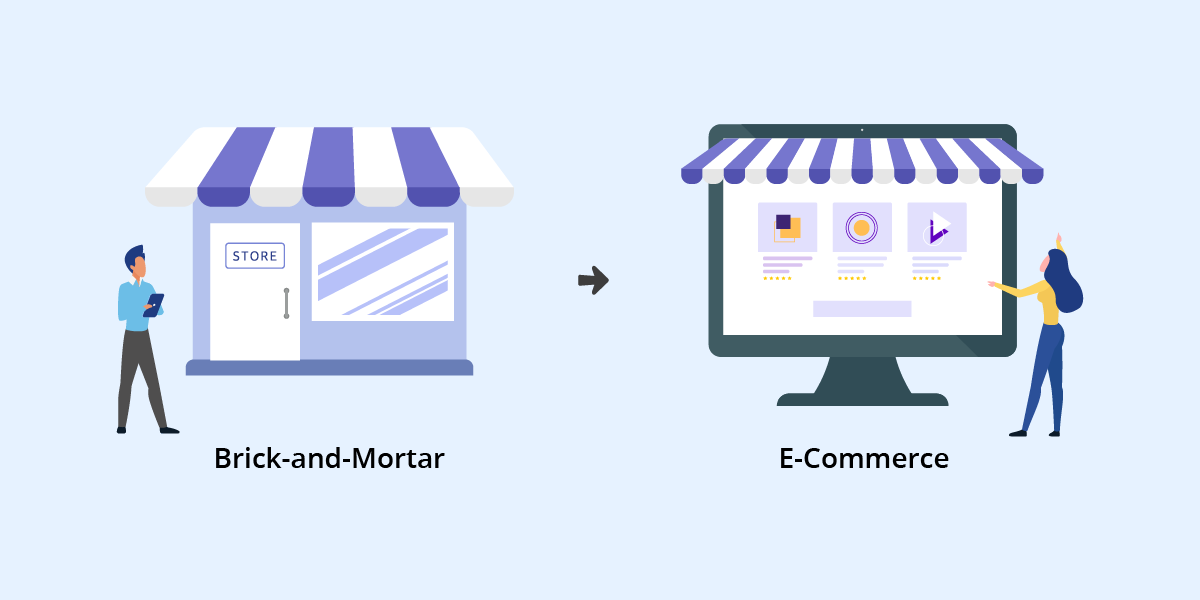
It’s easy to get a small business up and running by renting a kiosk or small shop in a mall. There have even been big businesses today that actually started in home garages. As the revenue grows, the companies can upgrade to bigger and bigger offices to accommodate more employees and resources. At some point, merchants need to consider setting up an e-commerce website to allow the business to expand even more. One option could be moving away from the brick-and-mortar shops and be a purely online company. The alternative is to have both offline and online shops. We’ll delve into the pros and cons for both in this article.
Sticking with just the physical stores is a big no-no
You might have noticed that we didn’t list out having just physical stores as one of the options for the company to grow. The reason for this is that only operating physical stores severely limits your customer base. That’s not conducive for growing a business. You could stick with just brick-and-mortar shops but don’t expect your business to grow as much as it could. We definitely do not recommend this option. In addition, physical expansion might not be sufficient to support further growth, especially in today’s digital age.
Becoming a purely online company
Now, doing away with the physical stores and just selling online via your e-commerce website is one option as we’ve stated above. Setting up an e-commerce website can significantly enhance a company’s growth potential by providing access to a wider market, enabling 24/7 sales, and reducing geographical limitations. There are many businesses doing just that. Their customers just order stuff off their website then gets the items shipped to them.
While this is a viable business strategy, it does not bode well for increasing the company reputation or for building brand awareness. Depending on your products, some items may require a human touch as well as showrooms where customers can get a feel for the products. In-store sales personnel can also lend a human touch to the company image, making customers feel more connected to the products and brand.
Integrating physical stores with an online presence
This option gives the best of both worlds in terms of brand awareness as well as allowing a wider reach to customers on a potentially global scale. Customers who wish to touch and see the products before purchase, can do so at their nearest store.
Meanwhile, those who prefer convenience can just order their desired items via the online store and have them sent right to their doorsteps. By catering to both types of customers, the business can flourish more than with the previous 2 options.
Pitfalls to be aware of when running an online store
Merchants running an online store will eventually encounter some pitfalls. Transitioning to e-commerce requires careful planning and investment in technology, marketing, and logistics. Companies need to consider factors such as website design, payment gateways, inventory management, shipping logistics, and digital marketing strategies.
Below are the main things to be aware of:
Securing your IT infrastructure to safeguard customer data
First of all, having an online presence is basically inviting some hackers to try and penetrate your system to cause havoc. Like it or not, merchants need to have a good IT team with access to security tools like firewalls and antiviruses to protect the servers and networks.
Becoming a victim to a data breach is very bad publicity for any online company. Customers will no longer trust that their info will be safe from compromise, thus they’ll start shopping with other websites.
Being able to scale out when under heavy traffic
E-commerce sites must be designed to scale out when under heavy traffic. Having a huge Black Friday sale? Your websites will definitely get bogged down if you don’t have a properly designed website that’s scalable.
Merchants need to invest in a scalable IT infrastructure to cater for such high demand. If the e-commerce websites can’t scale and they go down, you will have lost huge amount of money. Customers won’t shop with you if your website won’t load or loads very slowly.
Screening all online orders for fraud patterns
Are you performing fraud checks on every online order? No? Then you’ll end up with a lot of fraudulent orders and get hit with huge number of chargebacks. That will eat into your bottomline.
Manual fraud checks by humans are just not practical when it comes to online orders. When you’re having a sale, you could be dealing with hundreds of orders per minute. It is impossible to screen all of them for fraud patterns without automations.
Using the FraudLabs Pro fraud screen solution can save the day
Using IP geolocation for e-commerce security involves leveraging the geographical information associated with an IP address to enhance various aspects of security and user experience. Fortunately, there is the FraudLabs Pro fraud screening solution, designed from the start with the express purpose of detecting fraudulent orders in e-commerce platforms. FraudLabs Pro can screen the IP address of the buyer, their names, email addresses, phone numbers, addresses, transaction quantity and amount, as well as check multiple blacklists. When merchants screen orders using the FraudLabs Pro service, they can rest easy that any fraudulent orders will be caught quickly without manual intervention.
Conclusion
FraudLabs Pro believes that everyone deserves to be protected from online fraud. By integrating the fraud screening service into online stores, merchants will be able to protect themselves from financial disasters. Merchants should sign up for the Free plan to start with and then upgrade to a paid plan once their business have grown beyond the free threshold.
Free Fraud Protection Today!
Start safeguarding your business with FraudLabs Pro Fraud Prevention at Zero Cost!